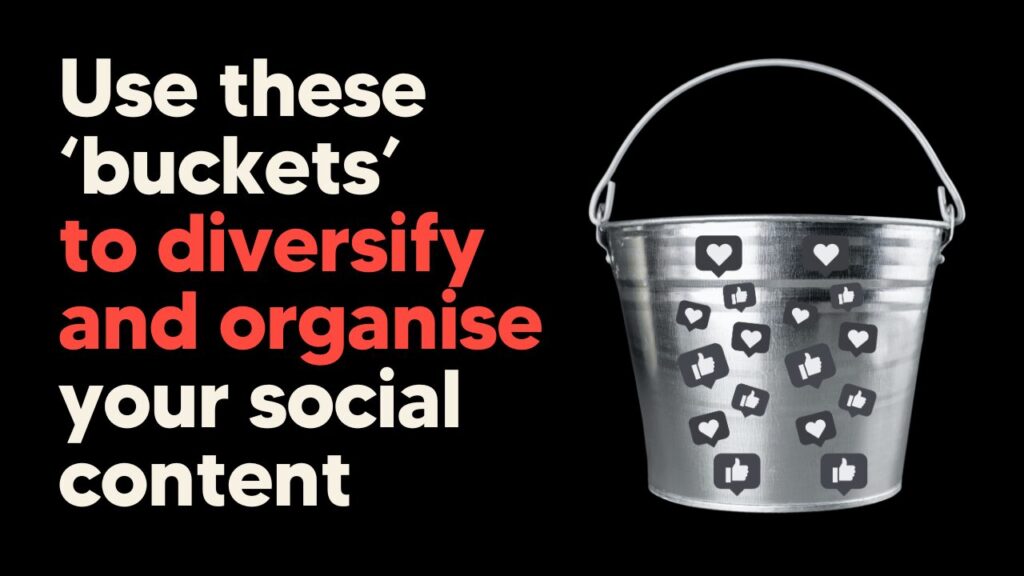
As business owners, we’ve got to make sure we don’t allow social media to consume us.
Not from the perspective of mindlessly doom-scrolling the feed, as addictive as this can be. No, I’m talking about the content side of things i.e. what to post to our social channels in order to build visibility, trust and authority.
Obviously, to be wholly purposeful in our efforts, we need to lay out a cohesive content strategy. But that’s not what this article is about. I’m not getting into the actual nitty-gritty of what issues and topics to post about, but more so wanting to give you some guidance as to the ‘categories’ of social media content you might like to consider.
Allow me to introduce you to my concept of ‘social buckets’.
This is a framework of sorts for diversifying and organising your social media content.
The essence of social buckets is to provide a balanced mix of content types, ensuring that your online presence remains engaging, varied, and purposeful.
Below, I unpack each of 10 social buckets that I recommend using as a starting point, complete with real-life examples for each.
For over a decade, I’ve used these buckets to help guide the social content efforts of many of my service-based business clients – growing companies and thought leader/solopreneur types.
You don’t need to use any or all of these, but rather what you think might be right for you and your business, particularly from a planning standpoint. Feel free to add your own to the mix!
Now, some of what I share below falls into the ‘Well, that’s obvious’ category, but I can say hand on heart, that few business people zoom out in order to think things through when it comes to their social media content.
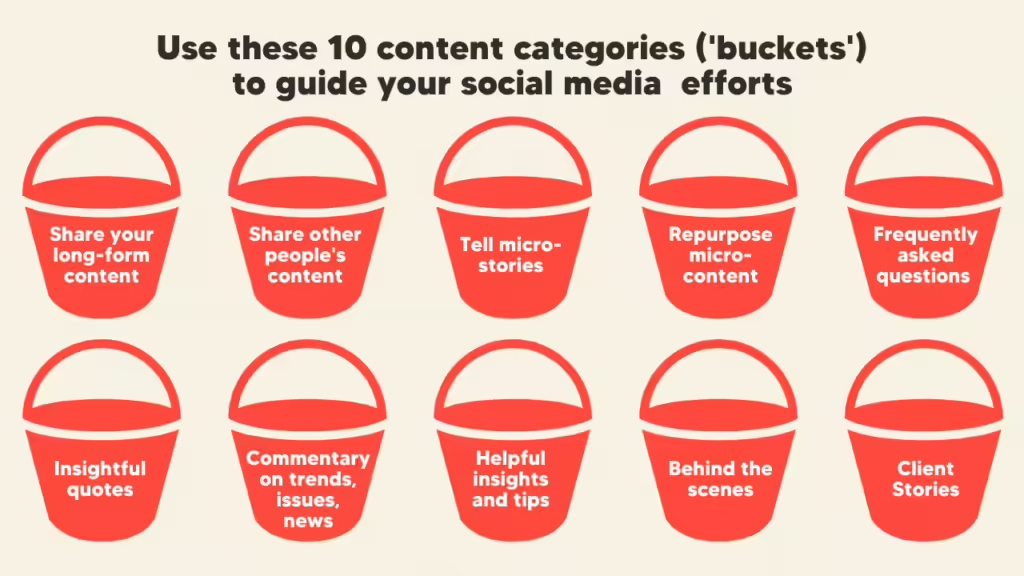
Yes, much of it is common sense, but as we know, common sense ain’t that common! We all need to be reminded of such things at times!
Okay, let’s rip into it!
1. Sharing our own long-form content
Sharing our own long-form content across different platforms is fundamental to guiding our audience back to our ‘owned media’ content hubs, such as blogs, podcasts, and YouTube channels. Let’s face it, we want our audience to engage on (and subscribe to) our channels – not Mark Zuckerberg’s!
Granted, while the social channels today don’t like sending users away from their platform and will penalise posts containing external links, to me, that’s not sufficient reason not to post about the long-form content you’ve published on your own channels.
You know me, I’m an owned media guy first. Make sure you share what you create!
But, don’t forget to also share any third-party editorial coverage gained – earned media, as we call it.
If you’ve been interviewed on someone else’s podcast – share it!
You’re speaking at an online summit – share it!
You’ve just been interviewed by your local newspaper or the niche publication that serves your industry – share it!
The goal here is less about beating your chest for the sake of it, but more so, reinforcing that you’re the real deal, a credible player in your field.
Here are three examples 👇
Ian Whitworth always provides a bit of a story when sharing his blog articles
I like how Leanne features the URL on the graphic rather than include the direct link
within the post itself (and risk being penalised by LinkedIn in terms of reach)
Ashley Faus often gets invited as a guest on other people’s podcasts,
which she then promotes on LinkedIn.
2. Sharing other people’s long-form content
Not all shared content should be your own. I believe that incorporating high-quality, relevant content from other people adds value to your social media feed.
Highlighting valuable content from other experts, thought leaders and peers (articles, podcasts, or videos that you think will resonate with your followers) not only demonstrates your engagement with the industry you operate in, but also builds goodwill and professional relationships.
But be judicious about it. This is about content curation – that means being strategic and thoughtful as to what you share.
Oh, and don’t forget to add your own opinion or perspective in the caption as well!
Here are a couple of examples 👇
Sharing Mark Schaefer’s newsletter article
Sharing Chenell Basilio’s YouTube presentation - preceded by a riff from my good self
3. Micro-stories
The most effective micro-stories are brief and impactful narratives or lessons learned that provoke thought, provide inspiration, and/or offer insights or ‘value bombs’.
Micro-stories work because they’re rooted in reality, and done well, come with a fair dash of humanity (and hopefully humility).
Whether it’s on Twitter, LinkedIn, Instagram, or Facebook, bite-sized stories can capture attention and provoke discussion!
Share yours today, build relatability with your audience, and watch your engagement grow!
Here are a couple of examples 👇
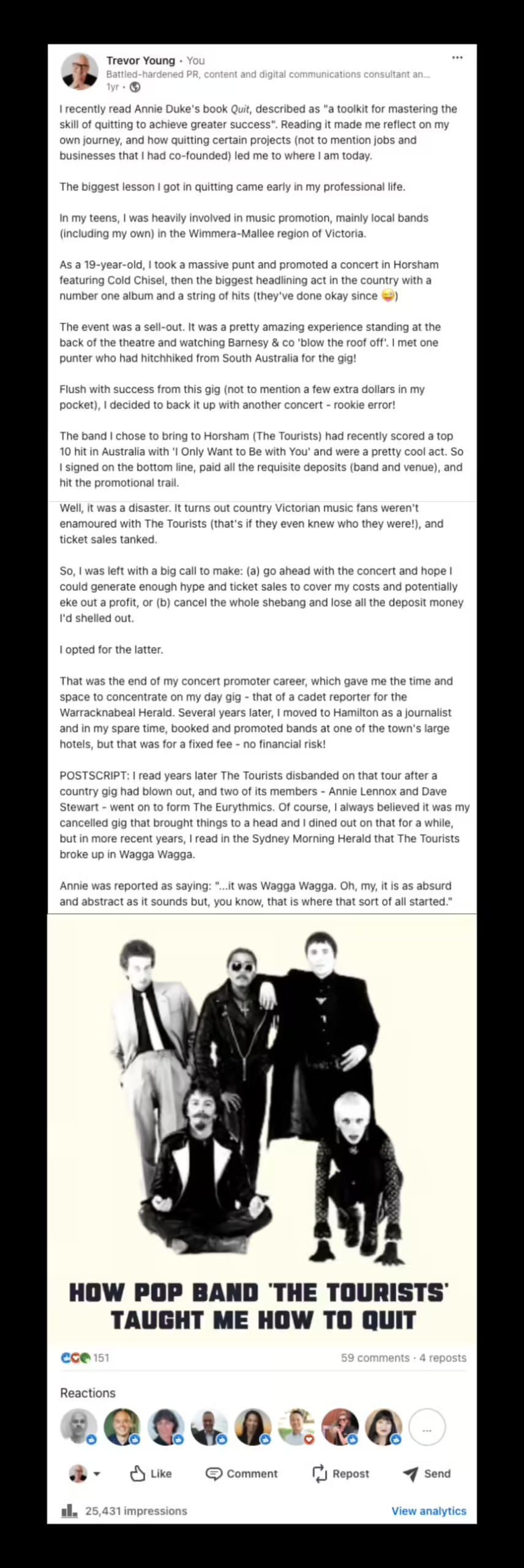
This story of mine struck a chord with my followers on LinkedIn
UK-based Gordon Fong is terrific at documenting his professional journey,
telling his and other people’s stories on a regular basis.
4. Repurposed micro-content
Repurpose segments from your long-form content into standalone posts to extend the value of your efforts.
Whether it’s a video snippet from a podcast interview you’ve recorded, or a golden nugget (paragraph) from a book or blog article you’ve written, breaking down your valuable long-form content into small and punchy micro-chunks can be a powerful way to reach new audiences for your owned media channels.
The goal is to not just get more value from your content efforts, but also lay a trail of ‘digital breadcrumbs’ that lead back to your meatier content.
Better still, produce these snippets in bulk (outsource this job if you can) and schedule out for a few months to help build a consistent drip-feed of content for your chosen social media feed.
Here are a couple of examples 👇
This is an excerpt from a podcast interview I conducted with
Rita Zonius (aka ‘The Social Enterprise Social Engineer’)
5. Frequently asked questions (FAQs)
Address common questions from your clients and customers to provide useful information and fill any knowledge gaps they might have.
FAQs are an easy ‘get’ from a content perspective!
They’re relevant and useful for your ideal target audience, plus they also demonstrate your knowledge and expertise, that you know what you’re talking about. This in term enhances your credibility in the marketplace.
My preferred format is <60 second vertical video, but equally, you could create a graphic in Canva highlighting the question, and then answering it using text in the caption.
I reckon you could easily come up with at least 20 often-asked questions you hear in your business – this is a challenge I set my clients, and it never fails to give us a terrific head start with our content calendar.
Seriously, do this and you’ll already been so far ahead of what your competitors are doing, it’s not funny!
Here’s a good example of what I’m talking about 👇
6. Insightful quotes
Quotes can be highly effective, especially when they are insightful, compelling, and relevant.
Use quotes from industry leaders, inspirational figures, or from interviews you’ve conducted. Feature them on a visual tile created on Canva, then pop a relevant comment or two in the caption.
You can even create and share your own quotes that capture your business philosophy or key messages.
I wouldn’t do them all the time, mind you, just pepper your feed every now and then with a quote to break it up and keep things interesting.
But please: Stay away from hackneyed quotes that everyone posts on social media (i.e. anything from Richard Branson!).
Go niche, quirky … I keep an online folder for collecting such quotes, so I always have one on-hand to publish if the need arises.
Here are a couple of examples 👇
Don’t forget: Visuals can carry a lot of weight!
Quote inspiration is everywhere!
7. Commentary on trends, issues, news
Offer your expert take on trending topics, news items, or industry issues to position yourself as a thought leader, or at least a leading voice on your chosen topic.
Staying current with industry trends, issues, and news is crucial for anyone wanting to build visibility and credibility in the marketplace.
Offering your take on these topics demonstrates that you are engaged and knowledgeable about your field.
Whether it’s through a text post or a video, providing commentary on current events can position you as an authority in your space.
But don’t dilly-dally – when issues hit the news (or more likely today, the social media feeds!), you need to take action and get your hot-take out on LinkedIn, or Twitter, or Instagram, or TikTok … pronto!
Here are a couple of examples of what I’m talking about 👇
Crisis public relations management expert, Molly McPherson, is really growing a
solid social media following for her bite-sized comments
Tyler Chou, the creator’s attorney, is building momentum as a media commentator
8. Helpful insights and tips
People love useful content that can have a tangible impact on their lives or businesses.
Share bite-sized tips, advice, and actionable insights that your audience can easily digest and apply.
These tips – i.e. utility-based content – can cover various aspects related to your industry or area of expertise, and help solidify your authority in the public’s eye.
Remember: No-one ever went wrong being (genuinely) useful and helpful!
Here’s a good example of that 👇
Co-founder of Brand Builders Group, Rory Vaden,
regularly provides helpful personal development tips
9. Behind the scenes
Publishing behind-the-scenes content can humanise your brand and give your audience a glimpse into your operations. I refer to it as taking people behind the velvet rope of your business.
Whether you are a solopreneur or run a growing company, sharing moments from your professional life or workspace can create connection and relatability with your audience.
Content-wise, this could include anything from prepping for a big presentation to introducing your team members to showing off your new digs (or home office).
This sort of post usually does very well on social media, so resist the temptation of over-do it. Think of it as cream on the top! Oh, and think VISUAL – photos and short videos work best here!
Here are three varied examples 👇
10. Client stories
Highlighting client stories is a powerful way to showcase the impact of your work.
These stories can be full testimonials or mini case studies that detail how you’ve helped clients overcome challenges.
Featuring your clients also promotes their businesses, which makes it a win-win all round!
Exhibit ‘A’ your honour! 👇
Rounding up …
By diversifying your social media content using these 10 social buckets (or adding your own), you can keep your audience engaged, advance the narrative of your business, and ensure consistent, valuable interaction with your followers.
Try incorporating these strategies into your content plan; feel free to experiment with different formats, and keep an eye how what resonates with your audience.
Oh, does this mean you can’t promote your products or services? Of course not. If you create promotional content every now and then – say 10-15 per cent of your total output – give it a bucket and add it to the list.
At the end of the day, all I’m trying to do here is give you some parameters to work within. There’s absolutely no problem extending beyond these parameters, we just want a base to work from!



Leave a Reply